As with everything I write about movies, there are spoilers ahead. And if you have even the slightest intention of ever watching this movie – which you TOTALLY SHOULD – please stop reading right now. Lair of the White Worm is so weird, so gleefully bonkers, that a full %70 of my enjoyment of the film came from the surprise factor; from the “Oh my god did that just really HAPPEN?! Am I WATCHING this?” aspect of the experience. And I wouldn’t want to ruin that for you. But if you are never going to watch it anyway – and I’ve got to imagine that applies to most of you – then by all means read on. Note: some images below the jump could be classified as NSFW. Not in the way we usually think about these things, but still… it’s a hard R, you know?
So like I said, Lair of the White Worm is a Ken Russell film. Ken Russell is a pretty interesting guy, known for Oscar nominated adaptations of DH Lawrence, BBC documentaries, the film version of Tommy, and for appearing on the British edition of Celebrity Big Brother last year at the age of 80 (where he kept the other housemates awake with thunderous snoring). He also made Lisztomania, a film in which Ringo Starr is cast as the pope, and Rick Wakeman from Yes is cast as the norse god Thor. Russell definitely an “artist,” a “great director,” but his movies are weird and polarizing, and his overall career rating at Rotten Tomatoes is %56.
In terms of straight-up weirdness, Lair of the White Worm is hard to beat (although Lisztomania could take it to the cleaners… did I mention that Ringo Starr is the pope?). It’s roughly based on a book by Bram Stoker, who in turn based it on some dragon legends from Britain’s North Country. Yes, “Worm” in this case is the old anglo-saxon “Wyrm,” meaning “dragon” (as one of the characters helpfully spells out for us within the first ten minutes of the film). According to the legends, the dragon was killed by the local lord, John D’Ampton, when he came back from the crusades. And to this day (in the world of the film), his family celebrates the event by putting on an annual crazy puppet show cum folk-rock dance party for the locals.
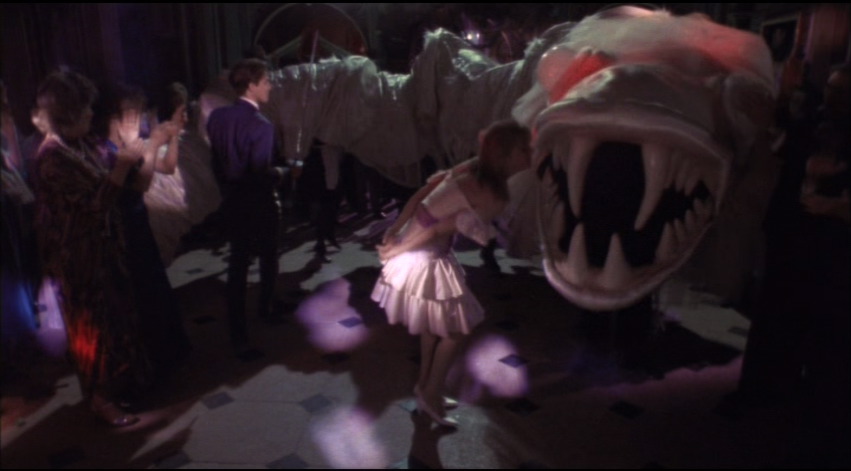
And just in case you can’t make it out in the image above, yes, that is a young Hugh Grant playing the part of the current Lord D’Ampton. Grant is quite good in this, but it’s kind of weird to see him act without slipping into his nebbishy Hugh Grant persona. You know, that charming/befuddled thing he does where he talks and acts exactly like Woody Allen only gorgeous and with a British accent?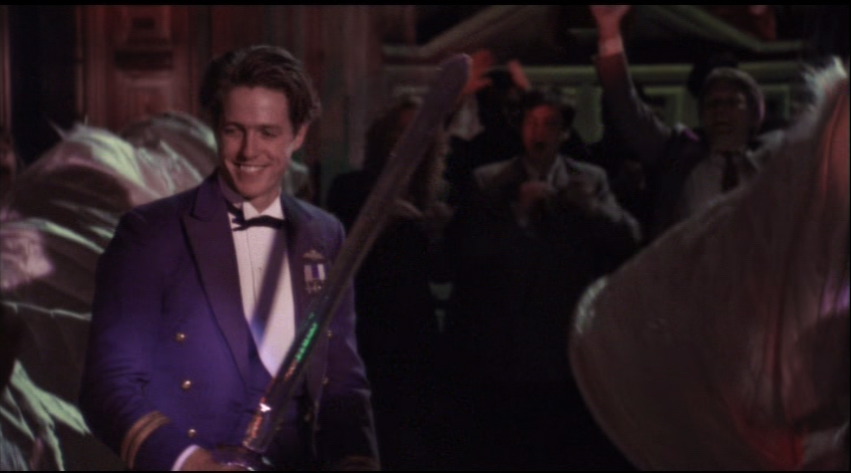
The film starts off with a visiting archaeologist unearthing the skull of the D’Ampton worm. It turns out those legends weren’t just legends after all. What’s more, the worm wasn’t just a worm: it was the pagan snake god Dionin. And gods are hard to kill permanently. It turns out that Dionin is still around (perhaps hiding in some sort of… lair?), and so is his posse of creepy snake-vampire cultists. (The vampire aspect appears nowhere in Stoker’s novel or the original legends. Russell threw it in for the film, presumably thinking that if you’re going to market something as a Bram Stoker adaptation, it had better well have vampires in it.)
This is the Snake Vampire head honcho No. 1, Lady Arabella Marsh (Amanda Donohoe). Donohoe’s performance is one of the best thing about this movie. And I’m not saying that just because she spends a lot of time walking around in her underwear, really. Even though you find out pretty much right away that she’s quite a cold-blooded killer (ha! Because she’s a reptile, get it?), you end up pretty much rooting for her, if only because she seems to be having so much more fun than any of the other actors. She spends most of the movie – well, she spends a lot of it just flouncing around, tossing off one liners, and generally portraying the sexy sexy danger. But she’s ostensibly trying to return Dionin to power by performing a human sacrifice. A virgin sacrifice. Which is hard, since, as she puts it, “Virgins are in such short supply these days.” Luckily for her (what are the odds!), Hugh Grant’s love interest just happens to fit the bill.
From that point on, it writes itself. Or it would, in the hands of someone other than Ken Russell. In Russell’s hands? Not so much. Because along the way, for some reason, THIS happens.
And this.
Lady Sylvia: “To die so that the god may live is a privilege, Kevin. And if you know anything about history, you know that human sacrifice is as old as Dionin himself… whose every death… is a rebirth… into a god ever mightier!” [Doorbell rings.] Lady Sylvia: “Shit.”
And this.
And this.
That last image makes me think of something… I wonder what it could be?
There’s a lot more that one could say about this movie. Just tracking through the blatant phallic and yonic symbols would take a post and a half. Trying to answer the perennial question of “Sexist? Or holding a dark mirror up to sexism?” would take at least two more. And it has more fun sneaking visual references to the title into the frame (in the form of garden hoses, earthworms, etc.) than any movie I’ve ever seen with the possible exception of John Woo’s Face/Off. But I think the pictures tell you more about the movie than anything I could write. If you find them hilarious, or disturbing, or hilariously disturbing, Lair of the White Worm is a must-see.
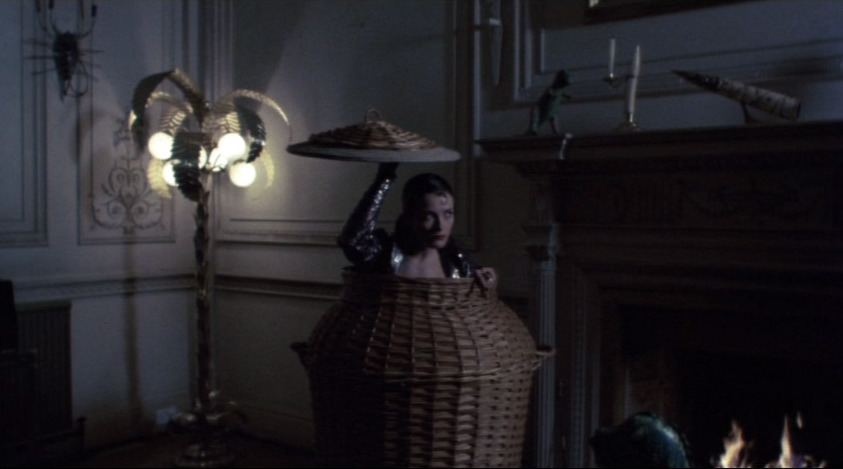
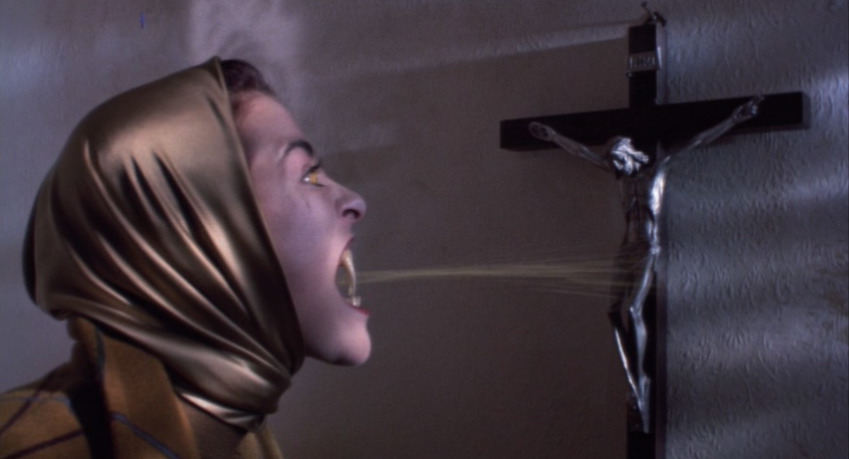
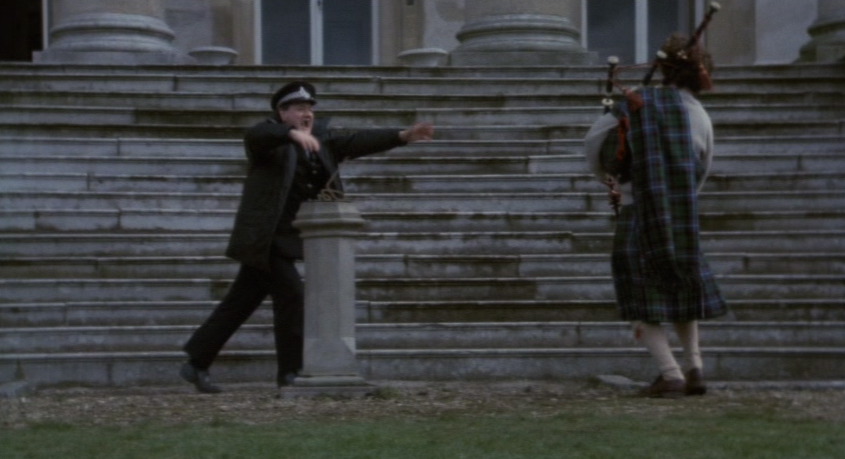
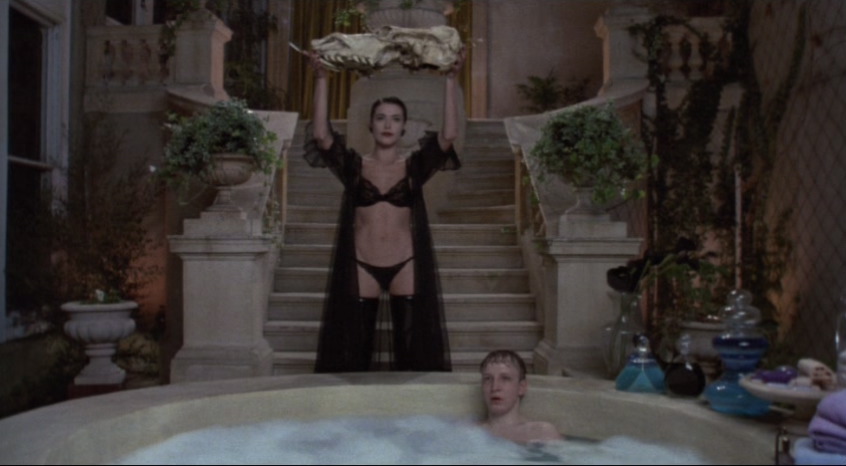
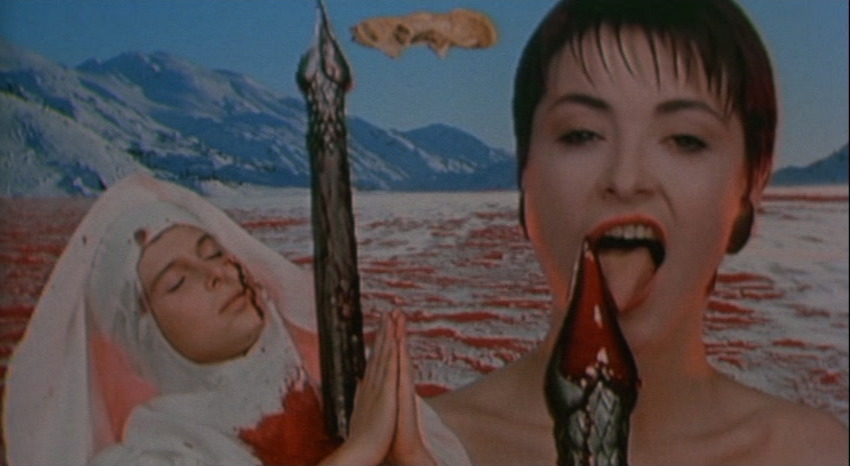
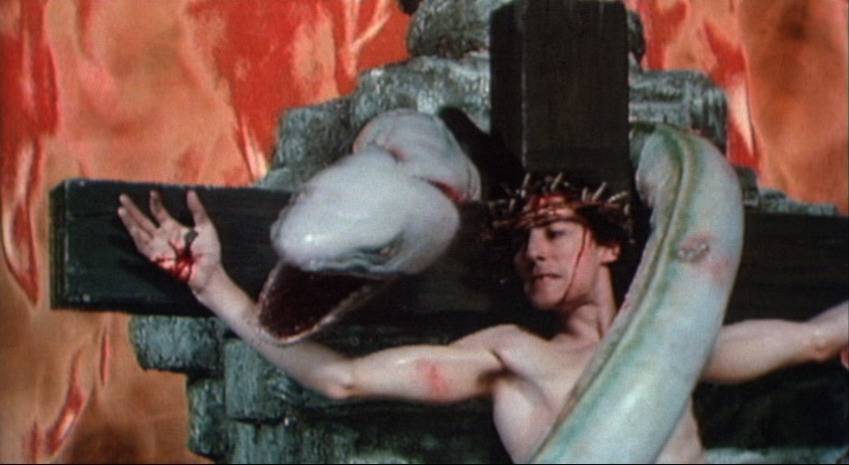
Dude. This looks even better than “Leeches.” Excuse me; “Leeches!”
Here it is: http://www.imdb.com/title/tt0339288/
Oh my god, Leeches looks amazing! The fact that the IMDB title is “Leeches!” but the poster clearly just says “Leeches”? The fact that the featured review on IMDB complains “I stopped counting nipples at about 1,000; sadly all male”? The fact that its Canadian director is also responsible for the films “Grizzly Rage,” “Beastly Boyz,” “Witches of the Caribbean,” and “The Brotherhood IV: The Complex”? The mere fact that “The Brotherhood” has spawned three sequels? Unbelievable.
“‘Trying to answer the perennial question of ‘sexist.’ Or holding a dark mirror up to sexism?'”
An interesting statement. At first glance, I have never thought of this. On second glance, I think you might be right. Would you care to expound on your statement, including your definitions of “sexist” and “sexism?”
As for my thoughts . . .
One, while most of the film characters, who express sexist comments, are male, here we have a female character, who expresses sexist comments.
Two, Ken Russell may be an equal opportunity sexist, as the men in the flm are treated as badly as the females in the film, if not worst.
Angus (Peter Capaldi)
Slapped with a dead animal. Bitten. Dragged down the hall. Thrown down a flight of stairs. And vampirized.
Erny (Paul Brooke)
Lured into her web of evil and vampirized, which leads to her death.
Joe (Christopher Gable)
We can presume that he met a most foul death during the past year.
Peters (Stratford Johns)
Bitten on the face and thrown off the balcony to his death.
Kevin (Chris Pitt)
And poor little Kev. Has any teenage boy scout ever being more harshly treated at the hands of a woman. Just when he thinks he’s going to make it with the hottest woman he has ever seen and receiving his first taste of oral sex from a woman, he is bitten on the penis by this woman. Paralyzed. Has his body ordor and breath insulted. And then drowned in the tub, when the doorbell rings.
James (Hugh Grant)
He is the only male in the film, who is not badly treated, but after the end of the film, he is most likely attacked by Angus and vampirized.
I would also add that the scene between Lady Sylvia Marsh (Amanda Donohoe) and Kevin is somewhat similiar to an earlier scene in “Horror Hotel” with Christopher Lee.
The sexism I’m worried about here isn’t so much the violence that is inflicted on women, rather, it’s the dichotomy between Lady Sylvia (extremely sexually aggressive, and smarter, wealthier, and more powerful than the male characters) and the Trent girls (sexually passive/inexperienced, and subservient to the men intellectually and financially). The film seems to believe that if you’re a woman who doesn’t conform to traditional gender roles, you’re probably an evil snake-vampire, and should be killed as soon as possible. Not exactly the message we should be sending to our daughters.
But the dichotomy is SO over the top that it’s hard to take seriously. It’s not like Lady Sylvia just turns out to be a bitch, or even that she’s just evil. She’s not just “emasculating” because she’s a powerful woman, she bites a guy on the penis. She’s not just “unfeminine” because she’s confident and sexually aggressive, she’s unfeminine because she carries around a giant spiked phallus. And like I said, I more or less ended up rooting for Lady Sylvia anyway, because Donohoe’s performance is so strong. So it’s hard to say where the movie’s heart is. I kind of tend to give the film the benefit of the doubt, but I’m not %100 sure.
Ah, poor Kev. He does get a pretty raw deal!
Yes and no. How is that for dichotomy.
As for the dichotomy between Lady Sylvia and the Trent girls, it may not be as great as one thinks. Using the men in the film as a standard.
Lady Sylvia
extremely sexually aggressive=Yes
smarter=Maybe so, but only marginally smarter than
Angus.
wealthier=unless she has something stashed away,
which we do not see, Lord James seems to
be wealthier.
more powerful=Maybe so, but what good does this do
her, when even someone like Kevin
can get the better of her. “Let us
have some music.” she says. He
misunderstands her, picks up his
mouth organ, and causes her to
dance strangely.
Trent girls
inexperienced Eve=Yes. Mary=No.
sexually passive=I take this to mean that Eve
let someone else make the
decision for her. But in
1988, she chooses not to
take a husband, and in
286, she chooses not to
take a husband, by
entering a convent. Not
that it does her much
good.
subservient intellectually=Yes, as they
do not enter
the men’s
talks.
subservient financially=No. Indeed,
when their parents disappeared, and they
could have taken a man in to help them
run the B&B, Mary, both figuratively and
literally, puts on the pants in the
family, so they would not be
subservient financially to a man or men.
I agree. That is not exactly the message we should be sending to our daughters, but I would add, it is also a message we should be sending to our sons.
It may seem that I am disagreeing with you, but I am not, at least, on the major points you made. For, as you say, it is hard to tell where the film is at any time. For, as Richard Harrington, the film critic for the “Washington Post” points out, in the film, we have conflicts between . . .
ernest and decadent
paganism and Christianity
surreal and real
violent and bucolic
And to that, I would add the following conflicts, as well.
brains and brawn
comedy and seriousness
horror and spoof
masculine and feminine
sexual license and sexual restraint
Thatcherism and non-Thatcherism
The upper class and the middle and lower classes
and not only female and female, but also female and male. Indeed, unlike most films, most of the physical confrontations in the films are between the women and the men in the film.
And anyway, you have given me something to think about. And for that, I thank you.
figurativ